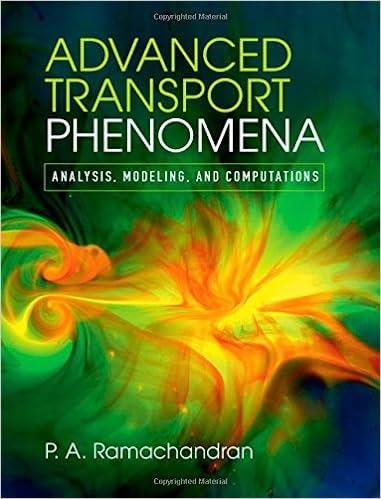The problem was solved analytically using complex variables. The perturbation method is also suitable for this problem
Question:
The problem was solved analytically using complex variables. The perturbation method is also suitable for this problem and provides additional physical insight into the solution.
The model equation in dimensionless form is restated here for ease of reference:
\[\begin{equation*}W o^{2} \frac{\partial v^{*}}{\partial t^{*}}=\cos \left(t^{*}\right)+\frac{1}{\xi} \frac{\partial}{\partial \xi}\left(\xi \frac{\partial v^{*}}{\partial \xi}\right) \tag{14.59}\end{equation*}\]
The term \(\cos \left(t^{*}\right)\) is the pressure oscillation, and the response of the pressure oscillation to changes in velocity is to be determined.
The three terms in the above equation may be interpreted as inertia, pressure, and viscous forces. Recall that \(W o^{2}\) is defined as \(\omega R^{2} / v\), where \(\omega\) is the frequency. The parameter \(W o^{2}\) is then ratio of the viscous diffusion time to the period of oscillation.
The first boundary condition is that there is no shear at \(\xi=0\), and hence \(\partial v^{*} / \partial \xi=0\) here. The second boundary condition is that of no slip at \(\xi=1\) and here \(v^{*}=0\). We are looking for solutions for the periodic steady state, and hence there is no initial condition in \(t^{*}\) applied for the time variable.
We wish to seek a perturbation solution to this problem for two limiting cases of small and large Wo. The case of large \(W o\) is examined in the next problem.
For small \(W o\) the velocity is expressed as \[v=v_{0}+W o^{2} v_{1}+\cdots\]
Show that the base solution when \(W o\) is zero is \[v_{0}=\frac{1}{4} \cos \left(t^{*}\right)\left(1-\xi^{2}\right)\]
which is the laminar flow under quasi-steady-state conditions. The inertia terms are nearly zero here, and the pressure forces are balanced by viscous forces. The flow is in phase with the pressure oscillation.
Then use this to show that \(v_{1}\) is \[v_{1}=W o^{2}\left[\frac{3}{16}-\frac{3 \xi^{2}}{4}+\frac{\xi^{4}}{16}\right] \sin \left(t^{*}\right)\]
This is the correction to the Poiseuille solution, and the contribution is out of phase with the pressure oscillation. Higher-order terms can be obtained if needed. The algebra is lengthy, but MAPLE can be used to ease the burden.
Step by Step Answer:

Advanced Transport Phenomena Analysis Modeling And Computations
ISBN: 9780521762618
1st Edition
Authors: P. A. Ramachandran





